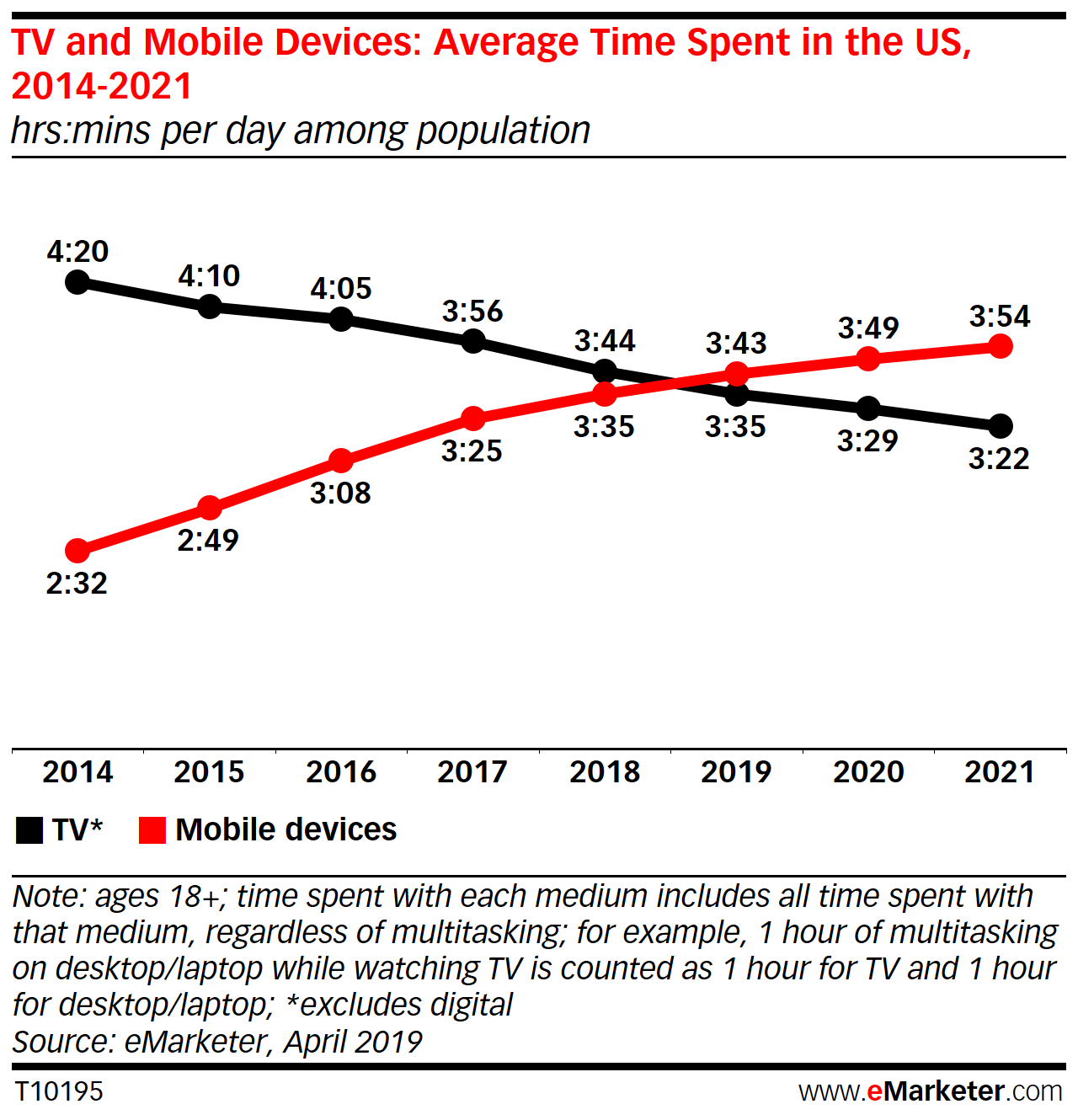Media
Americans Now Spend More Time on Mobile Devices Than Watching TV

Published:
Last Updated:

It was inevitable, right? After all, most Americans own smartphones and most carry those phones with them all day, every day. It turns out they’re not only lugging them around, but they’re also using them more.
Industry analysts at eMarketer project that the average American will be using a smartphone two hours and 55 minutes every day in 2019. Combined with time spent on other mobile devices, people will be using their mobile devices three hours and 43 minutes every day this year, and for the first time, mobile device use will surpass Americans’ time spent watching TV, projected at three hours and 35 minutes in 2019.
While eMarketer’s analysts expect mobile device use to plateau in 2021 at around three hours and 54 minutes, TV watching is projected to drop to three hours and 22 minutes that year.
People like watching on their mobile devices and smart TVs much more than they like subscription TV services like cable and satellite. A recent survey revealed that Americans really prefer streaming video — and not because of binge watching.
In 2014, Americans were watching nearly two hours more TV than they were spending on their mobile devices. That mobile devices would overtake TV was expected, but it did happen quickly, according to eMarketer’s principal analyst, Yoram Wurmser, who said: “We’ve expected that mobile would overtake TV for a while, but seeing it happen is still surprising.”
How are people spending their time on their mobile devices? Nearly three hours a day are spent on mobile apps, while less than half an hour is spent in a web browser. What does that mean? For one thing, that means that apps like Facebook and Amazon likely will be getting more attention than Google, and that means more advertising dollars are flowing to apps.
Apple’s recent announcement that it is killing iTunes and splitting the venerable music application into a suite of apps for games, TV, and news indicates that the company may be planning to put a stake in the ground for some of the ad dollars flowing into mobile apps. A free ad-supported tier for the new apps to complement a subscription service is just one way the company could boost its revenues, now that smartphone sales have flattened out.
Amazon’s ad revenues are expected to grow by 50% year over year in 2019 to 8.8% of a total market of $129.34 billion, according to an eMarketer report released in March. Google’s share is expected to dip by a point to 37.2%, and Facebook’s share is expected to increase slightly to 22.0%.
The most-used apps on mobile devices are music streamers like Apple Music, Spotify, YouTube and Pandora, just to name a few. Social media apps like Facebook, Twitter, Instagram and others are the second most popular.
Over the long term, eMarketer says, smartphones will remain the “dominant device for consumer media.” A recent study found that a third of teens wake up in the middle of the night just to check their phones.
Credit card companies are at war. The biggest issuers are handing out free rewards and benefits to win the best customers.
It’s possible to find cards paying unlimited 1.5%, 2%, and even more today. That’s free money for qualified borrowers, and the type of thing that would be crazy to pass up. Those rewards can add up to thousands of dollars every year in free money, and include other benefits as well.
We’ve assembled some of the best credit cards for users today. Don’t miss these offers because they won’t be this good forever.
Flywheel Publishing has partnered with CardRatings for our coverage of credit card products. Flywheel Publishing and CardRatings may receive a commission from card issuers.
Thank you for reading! Have some feedback for us?
Contact the 24/7 Wall St. editorial team.